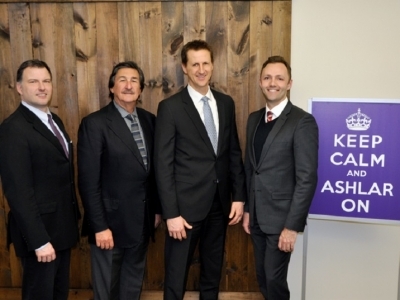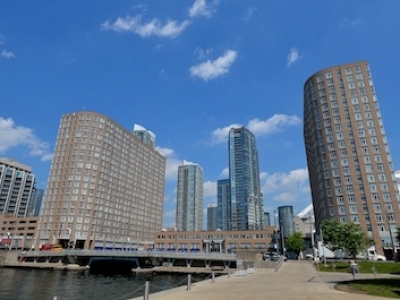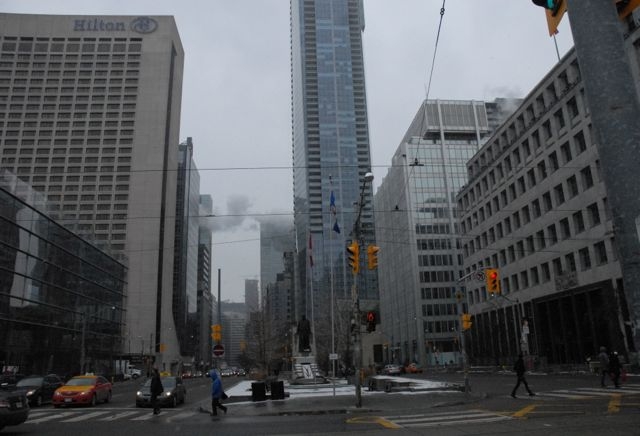|
The multi-residential sector in the GTA had a strong 2013, but obstacles to further growth remain, according to Ashlar Urban's John Carter. (As reality TV has shown us, put a lot of people in one living area, and things are bound to go south.)  A new report by Ashlar Urban Multi-Res Services Group (John, right, is with Ashlar teammates Marc Halbach, far left, Jeff Chelin, and Paul Campbell) shows that sales volume in the GTA multi-residential sector was up in 2013 ($1.26B, in 50+ unit buildings, highest level since 2004), cap rates remained steady (5.2%), and average prices per unit rose 3.5% (to $142k per door). “On the transaction side, we don't expect radical changes from what we saw in 2012 and 2013,” John says.  According to the report, a low average vacancy of 1.7% pushed owners to move ahead with purpose built multi-rez, rental projects, even conversions of what had originally been condo projects. Last year was the year of the large one-time seller; REITs and large institutional owners didn't dominate the landscape. Lower profile groups like The England Group made headlines with its sale of the 501-unit Maple Leaf Quay development (image) for a tad over $150M (4.5% cap rate). Starlight was by far the year's largest buyer—acquiring 19 buildings in the GTA, 2,651 units, for a total dollar volume of close to $347M.  The pace of construction of rental apartments isn't meeting demand in the GTA, according to John. The void is being filled by a “band-aid” solution—a secondary rental market of new condo construction, in areas that substantiate higher rent rates. Condo owners have different objectives and timelines with their property than a professional multifamily rental owner. (Who will be the first to write a West Side Story remake with condos vs. multi-fam.) Pictured: Starlight's 100 Dundas St E property acquired in December.  Demand for multi-rez is growing, John says, but obstacles like prohibitively high land prices, sites taken up for condo development, rising development charges, and rising construction costs impede development. What's needed is more consultation between the government and industry to address demand for more affordable housing that projects like these provide. An amortized payment program on development charges by the city is one way to go, rather than all up front, he says. |
|
 |
Eataly Coming North? Allow us to salivate a little. We have been to Eataly in NYC several times, and the high-energy, high-end Italian food market never disappoints. So when a story came out saying an expansion to Toronto was imminent, we called its NYC HQ. Eataly is definitely looking at expanding in several countries, Cristina Villa tells us, and, “Toronto is among the cities we are looking into.” No firm plans yet, nor a location. “It looks like Eataly Toronto won't happen for another three years or so,” she adds. (Still a shorter wait than Ortolan.) The rumoured location of Yorkville would be a fascinating add-on to the core's culinary offerings. |
 |
Carrier Joins ColliersColliers International Hotels's new AVP, Jessi Carrier, will work with the national hotel team out of Montreal. With a background in investments in hotel, restaurant, and related industries (he was also with GE Capital for seven years, responsible for mortgage and asset-based lending), Jessi says he wants to elevate Colliers' debt placement platform. Colliers has sold or financed over 80 Canadian lodging assets in the past 36 months, repping $1B in value. |
 |
 |
How Soft Is Your Street? |
||
 Toronto's downtown office market turned in its poorest results in Q4 '13 since 2003, with more space entering the marketplace than was leased, according to an Avison Young study. The question, AY VP and director of research Bill Argeropoulos tells us, is what will the impact be when the wave of new development combines with current market conditions? The ball is then in the tenants' court to seek out the most beneficial lease terms as the window of available options widens and narrows. “Irrespective of the quoted asking rental rates for a building or market, we all know that, in most cases, they're only a starting point for negotiations,” Bill says. |
 The study examined 140 existing (and under-construction) buildings covering all classes on Downtown Toronto's 10 prime streets for commercial space. A bit of perspective, though—in some cases, elevated availability rates are the result of large blocks of space in buildings under construction, space that will get taken up when transactions underway are completed. According to the study, only three streets (Yonge, Richmond and Wellington) are outperforming the overall Q4 '13 Downtown Toronto availability rate of 10.1%. |
|
 |





